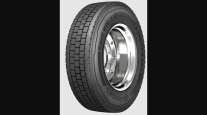Tire Sustainability Remains Top Priority for Industry

[Stay on top of transportation news: Get TTNews in your inbox.]
After they stop rolling, tires keep costing.
“End-of-life” tires that can no longer be retreaded are often stored in a drop trailer and taken away to a recycling facility. Tire industry experts say that’s the preferred environmental — and increasingly good business — practice.
“We have an objective of 100% of scrap tires being delivered into sustainable and circular end-use markets,” noted John Sheerin, director of end-of-life tire programs for the U.S. Tire Manufacturers Association. However, he warned increased scrap tire generation is outstripping an increase in recycling. “As a result, we’ve been losing ground on our percent recycled for some time.”
The association’s most recent U.S. Scrap Tire Management Report showed that in 2021 about 71% of scrap tires were delivered to end-use markets.

Tire industry experts contend that expanding the markets for materials recycled from scrap tires will be an ongoing effort. (Tire Industry Association)
The recycling market “unfortunately has been not growing enough,” Sheerin said, “and we are seeing more scrap tires going to landfill as a result.”
A separate challenge is scrap tires in illegal or abandoned stockpiles. In 1990, the Environmental Protection Agency estimated there were over 1 billion scrap tires at such sites. Fewer than 50 million remained in such locations in 2021, according to the USTMA report, a reduction of more than 95%.
Today there are storage and disposal regulations for scrap tires in 44 states, according to the Tire Industry Association; 36 states require financial assurance by scrap tire processors.
In Michigan, Kirsten Clemens, scrap tire coordinator in the state’s Department of Environment, Great Lakes and Energy, said her office does not regulate fleets unless they are hauling scrap tires or have more than 500 scrap tires collected on a site.

Clemens
It’s against state law to dispose of whole motor vehicle tires in landfills. Michigan registers scrap tire haulers — those hauling more than 10 tires commercially. The registrations are reviewed on an annual basis. The department also offers a micro website, Scrap Tires, that provides tire registration information.
Richard Gust, TIA’s CEO, said regulations in the states are designed to make sure that scrap tires are handled properly. He recalled “days gone by when people were putting them out in fields, tire piles were growing, [and] fires ensued.”
Expanding the markets for materials recycled from scrap tires is an ongoing effort, Gust and others said.
“At one time, tire-derived fuel — burning the tires — represented the highest form of managing the scrap tire flow,” Gust explained, adding that processing tires has increased “to the point where the ground rubber market is almost equal to the tire-derived fuel market.”
“We’re still working on making sure that we develop and create higher values for the recycled materials that are being produced today. More could be done,” he said.

To boost sustainability, tiremakers are seeking to increase use of recycled carbon black made from scrap tires. (Tire Industry Association)
Foremost in Gust’s view is promoting the use of rubber-modified asphalt. It is being used to some degree in several states, and “could consume every single scrap tire generated,” he said. “It is longer lasting and less expensive than asphalt.”
Tire-derived aggregate — tire chips that can be used in construction — is another product with a growing market, Gust said. Recycled tires are also processed into landscaping mulch, and backing for artificial turf and flooring. Whole tires are used in playgrounds.
Companies such as K&S Tire Recycling collect scrap tires from trucking companies, auto dealerships and tire retailers, and process them into ground rubber. Kevin Khalil, CEO of K&S, said that truck tires are “a higher-demand material” because they can be processed into ground or “crumb” rubber. “Crumb rubber is the finest material you can get — very similar to powder,” Khalil said.
K&S has a tire recycling plant in Illinois, and is building another one in that state, and one in Wisconsin, Khalil said. Besides those two states, the company operates in Indiana, Iowa, Michigan, Missouri and Ohio, and it has a fleet of vehicles, including tractor-trailers and box trucks, he added.
Sustainable support
Funding to support markets for recycled tire materials is available in 35 states that collect fees when a consumer leaves a tire at a generator’s location, according to TIA. States issue the collected fees in the form of grants to incentivize uses for scrap tires and create ongoing markets, said Gust.
Michigan’s Scrap Tire Program is funded by vehicle title transfer fees, Clemens said in a video posted on the department’s website.
As money from the $1.2 trillion Infrastructure Investment and Jobs Act is starting to be distributed to states, Gust thinks it could present an opportunity for the tire recycling community to benefit. However, he suspects that securing the federal funds would be “an arduous process.” Gust said the association is focused on “getting more of that money to go back to the states to encourage use of rubber-modified asphalt.”
Tiremakers are looking into changing up the mix of materials in their products, to increase recyclable and renewable ingredients. The Goodyear Tire & Rubber Co., Bridgestone and Continental have announced intentions to use certain percentages of sustainable and renewable materials in their tires.
Goodyear said it planned to sell a tire to the consumer market with “up to 70% sustainable-material content” this year. The company also announced that it had produced a demonstration tire comprising “90% sustainable materials,” Chris Helsel, senior vice president of global operations and chief technology officer, said in a statement, adding that the company is making progress toward introducing “a 100% sustainable-material tire” by 2030.
Bridgestone set a commitment to increase the use of recycled and renewable materials to 40% by 2030; and seeks to have 100% sustainable materials by 2050, according to Sarah Amick of USTMA. Michelin has set a goal to achieve 100% sustainable materials by 2050. The tiremakers are members of the association.

Amick
Amick, USTMA’s senior vice president of environment, health, safety and sustainability, and senior counsel, said that tiremakers are seeking to increase use of recycled carbon black made from scrap tires. Carbon black is nearly pure carbon in particle form. Manufacturers use it to improve strength and durability of tires. A process called pyrolysis, which applies heat in a near-absence of oxygen, is used to break scrap tires down into gas, oil and carbon black; the recovered carbon black can be reused in the manufacture of new tires.
“That has a huge CO2 reduction benefit,” Amick said. The process of extracting carbon black from scrap tires produces 81% less CO2 emissions compared to producing “virgin carbon black.”
Michelin and Bridgestone are working to incorporate ground tire rubber — micronized rubber powder — as filler in the manufacture of new tires, Amick said.
The finely ground material is vulcanized, observed USTMA’s Sheerin; small quantities can be used in new tires “without detrimentally affecting the properties of a tire,” he said. “If you add too much of it, then it can start detrimentally affecting the properties — the wet stopping distance and the durability.”
Tiremakers are also working to replace petroleum-based products with renewables. Amick said soybean oil is being used to replace traditional fossil fuel-based oils in some tires. Goodyear aims to increase its use of sustainable soybean oil, and has started using it in some consumer, commercial and racing tires, she said.
Want more news? Listen to today's daily briefing above or go here for more info
Rice husks are being researched by Goodyear and Pirelli as a potential replacement for silica, which is used in tires to enhance rolling efficiency, Amick noted. “It has been shown to deliver performance that’s similar to traditional sand-based silica,” she said.
Efforts are underway by some tire manufacturers to develop domestic sources of natural rubber. Noting that natural rubber is sourced from Southeast Asia, Amick explained tiremakers are “looking to develop sources closer to home.” Dandelions and guayule are potential domestic sources, Amick said.
Guayule is an evergreen shrub that originated in the Southwest and northern Mexico, “and therefore can be grown in environments totally different from those suited for para rubber trees (the current primary source of natural rubber),” according to Bridgestone, which stated on its website that guayule is “expected to become a new source of natural rubber.”




